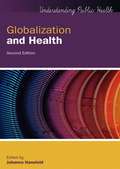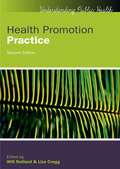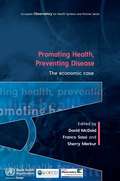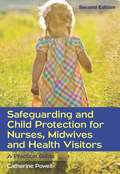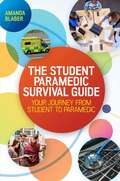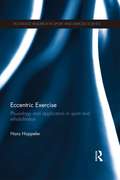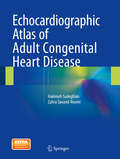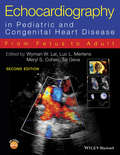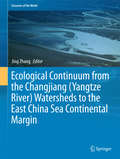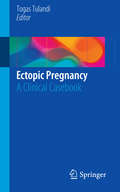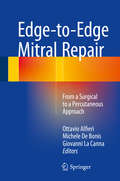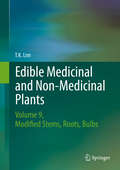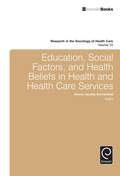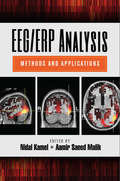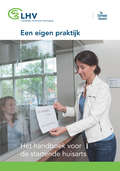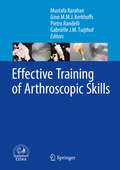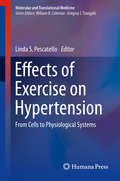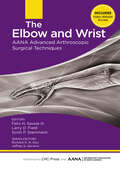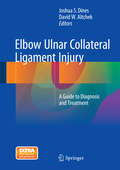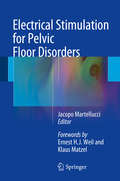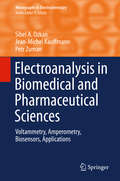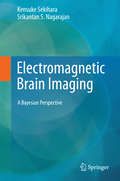- Table View
- List View
EBOOK: Globalization and Health (UK Higher Education Humanities & Social Sciences Health & Social Welfare)
by Johanna HanefeldPart of the Understanding Public Health series, this book offers students and practitioners an accessible exploration of global health.Global health is a relatively new but rapidly expanding field as public health practitioners recognize the important challenges that global changes are posing for human health. Health issues are increasingly crossing national boundaries, and this book explores the actors that shape global health, including private companies, foundations, civil society and multilateral organizations, and explores some of the key issues in global health.Illuminating the changes happening in health worldwide, the book includes practical activities and applications which help to show the impact of global issues at an everyday level. The issues covered include: Social change linked to globalizationGovernance of global healthPharmaceuticals and tobaccoEmerging infectious diseases Climate change Economy and trade Health securityGlobalisation and Health 2nd edition is an ideal resource for students of public health and health policy, public health practitioners and policy makers.Contributors:Joan Busfield,Nick Drager,Andy Guise,Johanna Hanefeld,Benjamin Hawkins,Kelley Lee,Marco Liverani,Tony McMichael,Neil Pearce,Richard Smith,Neil Spicer,Carolyn Stephens,Preslava Stoeva andHelen Walls. Understanding Public Health is an innovative series published by Open University Pressin collaboration with the London School of Hygiene & Tropical Medicine, where it is used as a key learning resource for postgraduate programmes. It provides self - directed learning covering the major issues in public health affecting low, middle and high income countries.Series Editors: Rosalind Plowman and Nicki Thorogood."This is a vital book which addresses the public health implications of accelerating globalisation. It shows with forensic clarity the dire impact neoliberal economics and burgeoning corporate power is having on individual, collective and planetary health. At the same time it holds out the hope that civil society can respond to this challenge and develop governance systems which ensure that the currently predominant free-market logic is reversed and people are once more put firmly before profits. Study it; learn from it; make a difference."Gerard Hastings, University of Stirling, UK, and the Open University"This book provides a clear introduction to how globalization is shaping our health and the determinants of health. The authors not only introduce us to the growing field of global health, but also provide some concrete evidence of driving factors, the key players and the impact on our daily lives. It should be a reference book for public health students, public health practitioners, as well as for policy makers. After I read this book I really realized that I live in a global village with all the consequences. Congratulations, it is a really great book."Asnawi Abdullah, Faculty of Public Health, University Muhammadiyah Aceh, Indonesia
EBOOK: Health Promotion Practice (UK Higher Education Humanities & Social Sciences Health & Social Welfare)
by Will Nutland Liza CraggThis fully revised public health text offers students and practitioners a grounding in the practice of health promotion and introduces a range of methods that are used in health promotion practice. It also helps to develop skills needed to do health promotion in a range of settings, including project management, partnership working, needs assessment and evaluation. Whether the public health intervention is through face to face contact with individuals, or community based or involves strategic policy development this book now also explores recent developments in social media and web based health promotion interventions.This second edition:provides practical guidance and tools for planning, delivering and evaluating health promotiongives greater emphasis to upstream health promotion interventions, including Healthy Public Policy and health advocacyincludes activities to help you make applications to your own study or practice of health promotion Health Promotion Practice, 2nd Edition is an ideal resource for students of public health and health policy, public health practitioners and policy makers.Understanding Public Health is an innovative series published by Open University Press in collaboration with the London School of Hygiene & Tropical Medicine, where it is used as a key learning resource for postgraduate programmes. It provides self-directed learning covering the major issues in public health affecting low, middle and high income countries.Series Editors: Rosalind Plowman and Nicki Thorogood.
EBOOK: Promoting Health, Preventing Disease: The Economic Case (UK Higher Education Humanities & Social Sciences Health & Social Welfare)
by David Mcdaid Franco Sassi Sherry MerkurThis book provides an economic perspective on health promotion and chronic disease prevention, and gives a rationale for assessing the economic case for action. It provides a comprehensive review of the evidence base in support of a broad range of public health interventions, addressing not only their effectiveness in improving population health, but also their implementation costs, impacts on health expenditures and wider economic consequences. An economic perspective is about more than counting the costs associated with poor health. It is about understanding how economic incentives can influence healthy lifestyle choices in the population. The book provides tools for developing effective and efficient policy strategies and addressing trade-offs between the goals of improving population health, while being mindful of the need to tackle inequalities in health outcomes across individuals and populations. The book:practically illustrates methods and measures of cost and outcome used in the evaluation of interventionscovers specific risk factor areas including tobacco smoking, alcohol, unhealthy diets, physical inactivity, poor mental health and harmful environmental factorsconsiders cross-cutting themes including key implementation issues, health inequalities, and the merits of early life interventionsThe book is designed for health policy makers and all those working or studying in the areas of public health, health research, medicine or health economics.
EBOOK: Safeguarding and Child Protection for Nurses, Midwives and Health Visitors: A Practical Guide (UK Higher Education Humanities & Social Sciences Health & Social Welfare)
by Catherine PowellNurses, midwives and health visitors have a statutory duty to safeguard and promote the welfare of children and young people. In this clear and invaluable guide, Catherine Powell focuses on the practical aspects of safeguarding and how healthcare professionals should respond to safeguarding children concerns. Key features of the book include: •Setting out the roles and responsibilities of nurses, midwives and health visitors working in a range of settings, including those working primarily with adult clients •Realistic case scenarios of physical, emotional and sexual abuse and neglect, covering infants, toddlers, school-age children and adolescents •Explanations of inter-agency working and the roles of other key players such as children's social care, the police and education services•'Markers of Good Practice' boxes highlighting lessons for practice.The book covers the full spectrum of safeguarding children work; from prevention and early help through to statutory intervention and serious case review. New for this expanded Second Edition are:•A new chapter on child sexual exploitation, and more consideration of risks for children online •More detail on the links between domestic violence and abuse and child maltreatment •New ‘Child Perspective’ boxes to encourage further thought about the voice and role of the childSafeguarding and Child Protection for Nurses, Midwives and Health Visitors 2e is an essential tool for students and will be invaluable for practicing healthcare staff who face an array of complex and sensitive issues in the field of safeguarding. “Dr Catherine Powell is the Institute of Health Visiting safeguarding expert, advising us on any national safeguarding issues or changes of policy. I am personally delighted that she has updated this important book. Safeguarding is the practice area that nurses, midwives and health visitors must not shy away from. It can however provide their greatest professional challenges as well as making them feel anxious about providing correct professional responses. This is a very well-structured and comprehensive book. The author very effectively brings safeguarding responsibilities to life with the use of case studies. The recurring features in the book are helpful and I very much like the inclusion of the child or young person’s perspective boxes. For the inexperienced professional this can be forgotten when swamped with a complex situation. By keeping the child’s perspective at the centre of all decision-making the right decisions are more likely to be made.Perhaps of particular value to learning will be the chapter on child death and serious case reviews, something professionals seek to avoid ever being involved in, but sometimes find themselves having to face. It is therefore important to learn from these reviews of what went wrong, a breakdown in professional communication so often being a feature. This chapter explains how a serious case review is carried out and allows the reader to understand how they might be asked to contribute to the process. To have a book such as this to use as a professional companion, not only to refer to and check facts, or underpin decision making, but also to expand professional knowledge, will lead to improved safeguarding practices, prompt, appropriate interventions, and better outcomes for children and families. Safeguarding is of course everyone’s business and others needing to refresh or update their skills in this area will also find the information included of great value.”Dr Cheryll Adams, Director, Institute of Health Visiting, UK“This is a very readable and practical book which achieves its aim to raise awareness about good safeguarding and child protection practice. The book is intended to prepare nursing, midwifery and specialist community public health nursing students and those ‘returning to practice’, but it will also be of use to more experienced practitioners who work with children, young people and their families, wanting to update their learning in the field. The book clearly reflects the author’s expertise and
EBOOK: The Student Paramedic Survival Guide: Your Journey from Student to Paramedic (UK Higher Education Humanities & Social Sciences Health & Social Welfare)
by Amanda BlaberThe Student Paramedic Survival Guide gives information and advice to help you succeed in your education and become a registered paramedic. The book supports you from the start of your journey as you choose a programme, through study and practice placements, to the final stages of registration and applying for work. Finally, the book prepares you to make the transition into your first paramedic job. To equip you with insights into what studying to be a paramedic is really like, the book is packed full of comments from students, paramedics, mentors, paramedic educators and academics. Their expertise and experience will be invaluable as you study and prepare for practice. Other useful tools are included, such as web links for suggested further reading. The book will answer questions such as: Is this the right career for me? What do I need to consider when choosing a university and programme of study? What will I be studying? How can I make the most of the simulations that are part of my course? Who is there to support me on placements? What is it like caring for patients and their families? How can I adjust to shift work? What can I do to prepare for registration and securing my first job?The book also includes advice on making the most of your preferred learning style and guidance on how to look after yourself when you encounter traumatic events.Written by a bestselling author with the help of students, practice staff and academics from a variety of higher education institutions, this guide for prospective and current student paramedics is the essential resource to support your journey through the excitement, challenges and realities of being a student paramedic on a higher education programme."This is a must buy for any student from school leaver to the mature candidate who is thinking of studying to be a Paramedic. The book comprehensively addresses everything from where and how to apply, unpicking the complex picture of fees and funding to the realities of what to expect when you get to University and what it’s like on placement. With valuable contributions from current students, academics and educators this book explains everything you need to know and might not have thought you needed to know before you apply."Mark Nevins, Senior Lecturer, Teeside University, UK, and NMC Registered Adult Nurse and HCPC Registered Paramedic"I would consider this book as required reading for anyone considering embarking on a career as a paramedic. It is honest, informative and true to life. I liked the way that all aspects of student life were covered, from applications, to studying and placements and finally being out in the world. This job isn't what a lot of people seem to think it is but Amanda has gone to great lengths to myth bust. This book shows a depth and consideration that all prospective paramedic students should appreciate. It is clear that a great deal of effort has gone into this survival guide."Mark Young, Paramedic & Practice Placement Educator, South East Coast Ambulance Service, UK "I liked the way that the book utilises a cross-section of students, practitioners and academics when providing opinions on the student paramedic journey, as this provides the triangulation required to ensure the views presented are representative of the student paramedic arena. It will provide a useful guide to the mysteries of the student journey. It is also useful that it illustrates the differences across the whole of the UK and considers the different approaches and how they can change the coping mechanisms that need to be used, and that are in place. The 4 sections provide an excellent overview of the 4 areas that most student paramedics want to, and need to, know, and answers a number of the questions (if not all) asked very effectively. The sections also support the needs of the profession, as well as the students own professional journey; covering a number of areas that are part of the institutional and ambulance Trusts inductions. It is useful to note that the Survival Guide also recognises the differences the student paramedic e
Eccentric Exercise: Physiology and application in sport and rehabilitation (Routledge Research in Sport and Exercise Science)
by Hans HoppelerEccentric muscle contraction, during which a muscle lengthens while under tension, is a fundamental process of human movement but a surprisingly under-researched area of exercise science. Evidence suggests that training programmes which incorporate both eccentric and concentric contractions can result in greater strength gains than concentric contractions alone, and this clearly has important implications for training and rehabilitation in sport and health. In Eccentric Exercise, leading international sport scientist Hans Hoppeler introduces the fundamental physiology and pathophysiology of eccentric muscle work, and explores the key applications of eccentric exercise in sport, rehabilitation and health. The book examines the molecular mechanisms responsible for tissue and organismic adaptations and discusses eccentric muscle-related pathology, specifically delayed onset muscle soreness. It assesses the use of eccentric exercise training in the treatment of certain disease states such as chronic obstructive pulmonary disease, heart insufficiency and sarcopenia, while a concluding chapter points to open research questions, shows the limits of the available data and highlights problems with current exercise modalities. This book is important reading for all sport and exercise scientists, clinicians working in rehabilitation, and high-level strength and conditioning coaches and trainers.
Eccentric Exercise: Physiology and application in sport and rehabilitation (Routledge Research in Sport and Exercise Science)
by Hans HoppelerEccentric muscle contraction, during which a muscle lengthens while under tension, is a fundamental process of human movement but a surprisingly under-researched area of exercise science. Evidence suggests that training programmes which incorporate both eccentric and concentric contractions can result in greater strength gains than concentric contractions alone, and this clearly has important implications for training and rehabilitation in sport and health. In Eccentric Exercise, leading international sport scientist Hans Hoppeler introduces the fundamental physiology and pathophysiology of eccentric muscle work, and explores the key applications of eccentric exercise in sport, rehabilitation and health. The book examines the molecular mechanisms responsible for tissue and organismic adaptations and discusses eccentric muscle-related pathology, specifically delayed onset muscle soreness. It assesses the use of eccentric exercise training in the treatment of certain disease states such as chronic obstructive pulmonary disease, heart insufficiency and sarcopenia, while a concluding chapter points to open research questions, shows the limits of the available data and highlights problems with current exercise modalities. This book is important reading for all sport and exercise scientists, clinicians working in rehabilitation, and high-level strength and conditioning coaches and trainers.
Echocardiographic Atlas of Adult Congenital Heart Disease
by Hakimeh Sadeghian Zahra Savand-RoomiThis atlas of echocardiography presents more than 100 cases of adult congenital heart disease, from diagnosis to treatment follow-up. The coverage is broad, encompassing atrial and ventricular septal defects, patent ductus arteriosus, cyanotic adult congenital heart disease, and numerous other anomalies, as well as findings on fetal echocardiography. For each disease, all echocardiographic images and views which proved of diagnostic value are arranged sequentially, with inclusion of transesophageal echocardiographic images whenever appropriate. Additional pertinent information is provided relating to diagnosis and treatment, and key teaching points are highlighted. The superb quality of the illustrations and the range of cases considered (including many rare ones) ensure that this atlas will be of great value for cardiology residents and fellows and highly relevant to day-to-day practice.
Echocardiography in Pediatric and Congenital Heart Disease: From Fetus to Adult
by Wyman W. Lai Luc L. Mertens Meryl S. Cohen Tal GevaThis comprehensive textbook on the echocardiographic assessment of pediatric and congenital heart disease has been updated for a second edition with an emphasis on new technologies. This highly-illustrated full-color reference contains over 1200 figures, and offers over 600 video clips on a companion website. Fully updated, with new chapters on the assessment of the post-Fontan procedure patient and on pregnancy and heart disease Each lesion chapter includes new section highlighting the key elements of the echocardiogram(s) Written by experts from the leading centers around the world, with numerous new authors Revision emphasizes new technologies and quality of images Comprehensive content contains overview of ultrasound physics, discussion of laboratory set-up, protocol for a standard pediatric echocardiogram and quantitative methods of echocardiographic evaluation, including assessment of diastolic function Also includes special techniques and topics including 3D echocardiography, intraoperative echocardiography, and fetal echocardiography
Ecological Continuum from the Changjiang (Estuaries of the World)
by Jing ZhangThe book provides a cross-disciplinary and multi-scale assessment of a world top river, the Changjiang (Yangtze River) and its adjacent marginal environment, the East China Sea. The studies in this volume bridges the watersheds of the river and the marginal sea through a combined approach of hydro-dynamics, geochemistry, sedimentary processes, ecology and fishery. The response of ecosystem to the external driving forces is examined via process-oriented observations, mesocosm experiments and numerical simulations in combination. The lessons learnt from the case studies of Changjiang and East China Sea can be beneficial to those who are doing inter-disciplinary researches in the continuum from watersheds to continental margins.
Ectopic Pregnancy: A Clinical Casebook
by Togas TulandiComprised exclusively of clinical cases covering ectopic pregnancy, this concise, practical casebook will provide clinicians in reproductive medicine and obstetrics/gynecology with the best real-world strategies to properly diagnose and treat the various forms of the condition they may encounter. Each chapter is a case that opens with a unique clinical presentation, followed by a description of the diagnosis, assessment and management techniques used to treat it, as well as the case outcome and clinical pearls and pitfalls. Cases included illustrate different management strategies – from treatment with methotrexate to surgical interventions – as well as types of ectopic pregnancy, such as ovarian, interstitial, heterotopic and abdominal forms, among others. Pragmatic and reader-friendly, Ectopic Pregnancy: A Clinical Casebook will be an excellent resource for reproductive medicine specialists, obstetricians and gynecologists, and family and emergency medicine physicians alike.
Edge-to-Edge Mitral Repair: From a Surgical to a Percutaneous Approach
by Ottavio Alfieri Michele De Bonis Giovanni La CannaThis is the first comprehensive review of the edge-to-edge technique for mitral repair, which was introduced into the surgical armamentarium in 1991 by one of the authors, Ottavio Alfieri. The surgical technique employed in edge-to-edge repair today provides the basis for the only reliable method of percutaneous correction of degenerative mitral regurgitation. The book traces the evolution of the edge-to-edge technique from a surgical to a percutaneous approach, documenting indications, contraindications, technical aspects, controversies and clinical outcomes. Detailed attention is devoted to the MitraClip procedure, which reproduces the Alfieri stitch percutaneously and has to date been used in more than 20,000 patients worldwide. The state of the art in MitraClip therapy is described, with clear explanation of when and how to use the MitraClip system. The reader will learn all aspects of percutaneous edge-to-edge repair, which is recommended for use in carefully selected patients in the new ESC/EACTS guidelines for the management of valvular heart disease and in the ESC guidelines on heart failure. The group at San Raffaele Hospital, Milan, has accumulated by far the largest experience in the world with the technique and over the years has been very active in its promotion and scientific evaluation. This book reflects that depth of knowledge and will be of great interest to cardiac surgeons and interventional and clinical cardiologists.
Edible Medicinal and Non Medicinal Plants: Volume 9, Modified Stems, Roots, Bulbs
by T. K. LimVolume 9 is part of a multicompendium Edible Medicinal and Non-Medicinal Plants, on plants with edible modified stems, roots and bulbs from Acanthaceae to Zygophyllaceae (tabular) and 32 selected species in Alismataceae, Amaryllidaceae, Apiaceae, Araceae, Araliaceae, Asparagaceae, Asteraceae, Basellaceae, Brassicaceae and Campanulaceae in detail. This work is of significant interest to medical practitioners, pharmacologists, ethnobotanists, horticulturists, food nutritionists, botanists, agriculturists, conservationists, and general public. Topics covered include: taxonomy; common/ vernacular names; origin/ distribution; agroecology; edible plant parts/uses; botany; nutritive/medicinal properties, nonedible uses and selected references.
Education, Social Factors And Health Beliefs In Health And Health Care (Research in the Sociology of Health Care #33)
by Professor Jennie Jacobs KronenfeldThis volume provides a unique sociological focus on education, social factors and health beliefs in health and health care, including a review of the literature to date. Beliefs and health beliefs are considered, including one study evaluating cross-national differences in public beliefs about the causes of health and the role of these beliefs in shaping attitudes to health policy. Another study focuses on the complexity and variation of health care system distrust across neighborhoods in one US city. The topic of education is addressed, including a focus on the importance of identification and intervention in low health literacy. Mental health issues are considered in the context of help-seeking, connections, transitions and utilization of care among adolescents. Social factors are reflected upon including race and ethnicity, literacy and socioeconomic status. Coverage also includes special and traditionally less visible populations, including the health of prisoners and carers of people with autism.
EEG/ERP Analysis: Methods and Applications
by Kamel Nidal Aamir Saeed MalikChanges in the neurological functions of the human brain are often a precursor to numerous degenerative diseases. Advanced EEG systems and other monitoring systems used in preventive diagnostic procedures incorporate innovative features for brain monitoring functions such as real-time automated signal processing techniques and sophisticated amplifi
Een eigen praktijk: Het handboek voor de startende huisarts
by Yuri Fisscher Caroline BemmelIn dit handboek staat alles wat nodig is om een eigen huisartsenpraktijk te starten. Met dit handboek biedt de Landelijke Huisartsen Vereniging de basis voor een goede praktijkstart. Biedt relevante informatie van A tot Z, is te gebruiken als naslagwerk en bevat 'to-do'-lijsten.
Effective Training of Arthroscopic Skills
by Mustafa Karahan Gino M.M.J. Kerkhoffs Pietro Randelli Gabriëlle J.M. TuijthofThis book explains how training in arthroscopic skills is best carried out in order to keep up to date with advances in arthroscopy, meet the ever-increasing demand for high-quality care, and respond to changes in available training time. State of the art developments regarding tools, performance monitoring, and learning strategies are presented, and practical guidelines provided for direct implementation in daily clinical practice. The coverage of simulation-based training ranges from the use of wet labs and box trainers through to sophisticated virtual reality simulators. Subsequent sections on objective performance tracking of training outside and in the operating room cover a variety of key aspects, including performance measures, evidence-based thresholds, preclinical training strategies, and the role of global rating scales, for objective monitoring. Readers will find the book invaluable in improving the efficiency and effectiveness of arthroscopic training.
Effects of Exercise on Hypertension: From Cells to Physiological Systems (Molecular and Translational Medicine)
by Linda S. PescatelloAs the first primer on the effects of exercise on human hypertension, Effects of Exercise on Hypertension: From Cells to Physiological Systems provides the state-of-the-art effects of exercise on the many possible mechanisms underlying essential hypertension in humans. The book contains chapters by distinguished experts on the effects of exercise on physiological systems known to be involved in hypertension development and maintenance as well as less well known aspects of hypertension such as 24-hour ambulatory blood pressure profile and oxidative stress. An emerging area, the effects of resistance exercise training on blood pressure is also covered. A unique aspect of the book is that it covers the effects of exercise mimetics on vascular cell adaptations in order to begin to elucidate some of the cellular mechanisms that may underlie blood pressure reductions with exercise training. Lastly, the book will end with a chapter on the interactive effects of genes and exercise on blood pressure. Chapters are grouped by physiological system or mechanism. The text begins with two overview chapters; one on the general effects of aerobic exercise training and the second on the general effects of resistance exercise training on blood pressure. Each chapter begins with a bulleted list of key points. Effects of Exercise on Hypertension: From Cells to Physiological Systems will be of great value to professional individuals in cardiovascular medicine, the cardiovascular sciences, allied health care professionals, and medical and graduate students in the cardiovascular sciences and medicine.
Effects of smoking- Pie Chart 1
by Sheffield Vi ServiceThis is a pie chart showing the effects of smoking on men aged 35 to 64.
The Elbow and Wrist: AANA Advanced Arthroscopic Surgical Techniques (AANA Advanced Arthroscopic Techniques series)
by Felix Savoie Larry Field Scott SteinmannCo-published with the Arthroscopy Association of North America, The Elbow and Wrist: AANA Advanced Arthroscopic Surgical Techniques is a comprehensive technique-based book that presents the latest diagnostic and reconstructive techniques in arthroscopic surgery for the elbow and wrist.The Elbow and Wrist: AANA Advanced Arthroscopic Surgical Techniques is authored by premier arthroscopic surgeons Drs. Felix H. Savoie III, Larry D. Field, Scott P. Steinmann, and their international list of expert contributors. This comprehensive resource includes preferred physical examination testing and diagnostic imaging choices in pre-operative planning and patient selection, state-of-the-art step-by-step description of the procedures, detailed surgical equipment lists to perform each procedure, clear and precise indications for surgery and the thoughtful rationale behind stated contraindications, controversial indications, post-operative protocols, and potential complications.The written text is supported by numerous color images and a website with invaluable, narrated video clips depicting disease specific arthroscopic techniques specific to the elbow and wrist.Features inside The Elbow and Wrist: AANA Advanced Arthroscopic Surgical Techniques Narrated video accompanies all surgical techniques, focusing on the stepwise approach to each operation Consistent organization throughout the book results in a bulleted and user-friendly interface for a quick reference or prolonged study Top 5 Technical Pearls for each procedure to enhance outcomes and to avoid common pitfalls and complications High-quality artwork and figures to compliment clinical images Equipment and surgical technique checklists for quick reference prior to surgery Each expert contributor was chosen for his or her expertise for a specific topic related to The Elbow and Wrist, so the reader benefits by the highest quality and treatment recommendations to provide state-of-the-art care to his or her patient.Some chapter topics include: Degenerative Joint Disease of the Elbow: Arthroscopic Management Open MUCL Reconstruction: The Andrews Technique New Techniques: The Future of Elbow Arthroscopy Arthroscopic Treatment of Distal Radius Fractures Endoscopic CT Release: The Chow Technique
The Elbow and Wrist: AANA Advanced Arthroscopic Surgical Techniques (AANA Advanced Arthroscopic Techniques series)
by Felix Savoie Larry Field Scott SteinmannCo-published with the Arthroscopy Association of North America, The Elbow and Wrist: AANA Advanced Arthroscopic Surgical Techniques is a comprehensive technique-based book that presents the latest diagnostic and reconstructive techniques in arthroscopic surgery for the elbow and wrist.The Elbow and Wrist: AANA Advanced Arthroscopic Surgical Techniques is authored by premier arthroscopic surgeons Drs. Felix H. Savoie III, Larry D. Field, Scott P. Steinmann, and their international list of expert contributors. This comprehensive resource includes preferred physical examination testing and diagnostic imaging choices in pre-operative planning and patient selection, state-of-the-art step-by-step description of the procedures, detailed surgical equipment lists to perform each procedure, clear and precise indications for surgery and the thoughtful rationale behind stated contraindications, controversial indications, post-operative protocols, and potential complications.The written text is supported by numerous color images and a website with invaluable, narrated video clips depicting disease specific arthroscopic techniques specific to the elbow and wrist.Features inside The Elbow and Wrist: AANA Advanced Arthroscopic Surgical Techniques Narrated video accompanies all surgical techniques, focusing on the stepwise approach to each operation Consistent organization throughout the book results in a bulleted and user-friendly interface for a quick reference or prolonged study Top 5 Technical Pearls for each procedure to enhance outcomes and to avoid common pitfalls and complications High-quality artwork and figures to compliment clinical images Equipment and surgical technique checklists for quick reference prior to surgery Each expert contributor was chosen for his or her expertise for a specific topic related to The Elbow and Wrist, so the reader benefits by the highest quality and treatment recommendations to provide state-of-the-art care to his or her patient.Some chapter topics include: Degenerative Joint Disease of the Elbow: Arthroscopic Management Open MUCL Reconstruction: The Andrews Technique New Techniques: The Future of Elbow Arthroscopy Arthroscopic Treatment of Distal Radius Fractures Endoscopic CT Release: The Chow Technique
Elbow Ulnar Collateral Ligament Injury: A Guide to Diagnosis and Treatment
by Joshua S. Dines David W. AltchekPresenting a comprehensive discussion of the biomechanics, assessment, diagnosis and management of injuries to the elbow ulnar collateral ligament (UCL), including video clips of selected surgical techniques, this is a thorough and practical text for any clinician seeing athletes with this increasingly common injury. The book is organized thematically, beginning with anatomy and biomechanics of the ligament. Diagnosis of these injuries follows, with chapters focusing on both physical exam tests and imaging studies. Chapters on both conservative treatment and surgical approaches form the heart of the text, including revision surgery and complications, and review the variety of techniques and expected outcomes. Additionally, individual chapters are devoted to the female and high school-aged athlete. Proper rehabilitation is essential and rounds out the text, including a unique focus on sports-specific rehabilitation. Written and edited by top clinicians in orthopedics and sports medicine, this book is an essential reference for diagnosing and treating injuries to the elbow UCL.
Electrical Stimulation for Pelvic Floor Disorders
by Jacopo MartellucciThis book will enable the reader to gain a sound understanding of contemporary and futuristic evidence-based interventions and assessment procedures for pelvic floor disorders. It gathers the experiences of some of the most important experts on electrical stimulation techniques, offering a multidisciplinary and problem-oriented approach organized according to therapeutic goals. Interventions are recommended that are consistent with theory and display clinical efficacy for specific disorders, including urinary incontinence or retention, fecal incontinence, constipation, pelvic pain, sexual dysfunction and neurological diseases involving the pelvic floor. All of the surgical or rehabilitative techniques requiring electrical stimulation for the treatment of these disorders are explored and essential background information is provided on functional anatomy, neurophysiology and concepts in electrotherapy. This volume will be a very useful tool for urologists, general or colorectal surgeons, gynecologists and anesthesiologists and also physiotherapists and alternative medicine practitioners (a specific chapter focuses on electroacupuncture). It will assist in their clinical practice as they seek to help the very many patients who suffer from any of the wide range of functional pelvic floor disorders.
Electroanalysis in Biomedical and Pharmaceutical Sciences: Voltammetry, Amperometry, Biosensors, Applications (Monographs in Electrochemistry)
by Sibel A. Ozkan Jean-Michel Kauffmann Petr ZumanThrough this monograph, the pharmaceutical chemist gets familiar with the possibilities electroanalytical methods offer for validated analyses of drug compounds and pharmaceuticals. The presentation focuses on the techniques most frequently used in practical applications, particularly voltammetry and polarography. The authors present the information in such a way that the reader can judge whether the application of such techniques offers advantages for solving a particular analytical problem. Basics of individual electroanalytical techniques are outlined using as simple language as possible, with a minimum of mathematical apparatus. For each electroanalytical technique, the physical and chemical processes as well as the instrumentation are described. The authors also cover procedures for the identification of electroactive groups and the chemical and electrochemical processes involved.Understanding the principles of such processes is essential for finding optimum analytical conditions in the most reliable way. Added to this is the validation of such analytical procedures. A particularly valuable feature of this book are extensive tables listing numerous validated examples of practical applications. Various Indices according to the drug type, the electroactive group and the type of method as well as a subject and author index are also provided for easy reference.
Electromagnetic Brain Imaging: A Bayesian Perspective (Series In Biomedical Engineering Ser.)
by Kensuke Sekihara Srikantan S. NagarajanThis graduate level textbook provides a coherent introduction to the body of main-stream algorithms used in electromagnetic brain imaging, with specific emphasis on novel Bayesian algorithms. It helps readers to more easily understand literature in biomedical engineering and related fields and be ready to pursue research in either the engineering or the neuroscientific aspects of electromagnetic brain imaging. This textbook will not only appeal to graduate students but all scientists and engineers engaged in research on electromagnetic brain imaging.
